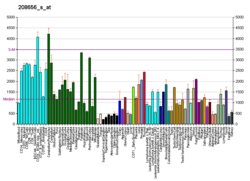CCNI (gene)
Cyclin-I is a protein that in humans is encoded by the CCNI gene.[4][5]
The protein encoded by this gene belongs to the highly conserved cyclin family, whose members are characterized by a dramatic periodicity in protein abundance through the cell cycle. Cyclins function as regulators of CDK kinases. Different cyclins exhibit distinct expression and degradation patterns which contribute to the temporal coordination of each mitotic event. This cyclin shows the highest similarity with cyclin G. The transcript of this gene was found to be expressed constantly during cell cycle progression. The function of this cyclin has not yet been determined.[5]
References
- 1 2 3 GRCm38: Ensembl release 89: ENSMUSG00000063015 - Ensembl, May 2017
- ↑ "Human PubMed Reference:".
- ↑ "Mouse PubMed Reference:".
- ↑ Nakamura T, Sanokawa R, Sasaki YF, Ayusawa D, Oishi M, Mori N (Jan 1996). "Cyclin I: a new cyclin encoded by a gene isolated from human brain". Exp Cell Res. 221 (2): 534–42. doi:10.1006/excr.1995.1406. PMID 7493655.
- 1 2 "Entrez Gene: CCNI cyclin I".
External links
- Human CCNI genome location and CCNI gene details page in the UCSC Genome Browser.
- Human CYC1 genome location and CYC1 gene details page in the UCSC Genome Browser.
Further reading
- Sun ZL, Zhu Y, Wang FQ, et al. (2007). "Serum proteomic-based analysis of pancreatic carcinoma for the identification of potential cancer biomarkers". Biochim. Biophys. Acta. 1774 (6): 764–71. doi:10.1016/j.bbapap.2007.04.001. PMID 17507299.
- Gerhard DS, Wagner L, Feingold EA, et al. (2004). "The Status, Quality, and Expansion of the NIH Full-Length cDNA Project: The Mammalian Gene Collection (MGC)". Genome Res. 14 (10B): 2121–7. doi:10.1101/gr.2596504. PMC 528928. PMID 15489334.
- Strausberg RL, Feingold EA, Grouse LH, et al. (2003). "Generation and initial analysis of more than 15,000 full-length human and mouse cDNA sequences". Proc. Natl. Acad. Sci. U.S.A. 99 (26): 16899–903. doi:10.1073/pnas.242603899. PMC 139241. PMID 12477932.
- Zhu X, Naz RK (1998). "Expression of a novel isoform of cyclin I in human testis". Biochem. Biophys. Res. Commun. 249 (1): 56–60. doi:10.1006/bbrc.1998.9052. PMID 9705831.
- Suzuki Y, Yoshitomo-Nakagawa K, Maruyama K, et al. (1997). "Construction and characterization of a full length-enriched and a 5'-end-enriched cDNA library". Gene. 200 (1–2): 149–56. doi:10.1016/S0378-1119(97)00411-3. PMID 9373149.
- Maruyama K, Sugano S (1994). "Oligo-capping: a simple method to replace the cap structure of eukaryotic mRNAs with oligoribonucleotides". Gene. 138 (1–2): 171–4. doi:10.1016/0378-1119(94)90802-8. PMID 8125298.
This article is issued from
Wikipedia.
The text is licensed under Creative Commons - Attribution - Sharealike.
Additional terms may apply for the media files.



